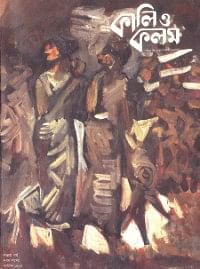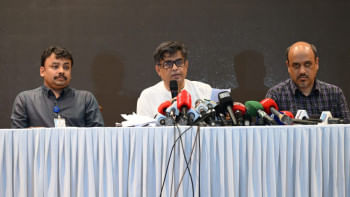<i>Kali O Kolom Kartik</i> 1415 - October 2008

This issue of Kali O Kolom continues its tribute to Manik Bandhapadhya on the centenary year of his birth by devoting four articles to him, by Hasan Azizul Haq, Hayat Mamud, Manbendra Bandhapadhya and Kumar Deep respectively. The latter's piece has the virtue of brevity, yet is interesting for its take on three of Manik's most well-known characters, Hirombo of Deebaratrir Kabya (1935), Shashi in Putul Naacher Itikotha (1936) and Rajkumar of Chotushkone (1942). It is Hasan Azizul Haq's article, however, that is the most interesting as it analyzes Manik's writing in the greater context of Bengali writing of that period, as well as assesses the specific characteristics which made, and still does, him a unique and widely read writer. In passing he also relates how an editor, confronted with an extract to be published from the novel-in-progress, probably recognized the merit of the writing and wisely advised much to the good of Bengali literature - the author to publish it as a novel. Ali Anwar's piece, written with considerable scholarship and titled 'Rabindranath's Mrittubhabna Shonglesh O Shongshoy,' is a meditative piece on the poet's broodings on death, mortality and 'existential angst'.
Jyotiprakash Dutta continues to extend the boundaries of Bangladeshi Bengali nonfiction writing by ruminating, both soulfully and lightly, on his experiences of 'calf love' during youthful times the hesitations, the heartaches are captured in a flowing Bangla prose, and through it can be glimpsed rural Bengal of a different era and ethos. There are two in-memoriums, one of Mohammed Muniruzzaman of Bangla department of Dhaka University written by Syed Mohammed Shahed and another of Zia Haider of the Drama department of Chittagong University by Biswajit Chowdhury. As one reads of their aspirations and contributions (Muniruzzaman, for example, at the end of the '70s when he assumed the chairmanship strove mightily to re-build the research facilities and work of the Bangla department), while Zia Haider, poet of the '50s, gave himself unstintingly to the world of Bengali drama from 1960s onwards. Both deaths are yet again reminders how an entire generation devoted to the arts (in the broadest sense of the word) is slipping away from us, and how such a generation in this new world of glitz and flash perhaps might never again be replaced.
There are four short stories, by Masuda Bhatti, Satyaki Haldar, Abu Taher Sarfaraz and Tarek Rez. All four are eminently readable, especially the ones by Sarfaraz ('Dhobla') and Rez ('Chayaghor'): Kali O Kolom is now reaching out for new voices, or at least voices that may not be overly familiar to readers of Bengali fiction. In this regard, no disrespect meant here, but it has become imperative to mention that the opportunity for artwork in its pages should perhaps also be extended to other, younger, upcoming artists, to once in a while freshen readers' eyes from senior artists (or one very senior artist!) who tend to occupy all such space. The baton should be handed on. Gently, of course, but it has to be handed on. In the previous Bhadro issue an article had critiqued Abid Anwar's classification of our '60s poets, and here the author spiritedly defends himself given the premises which he laid out quite specifically in his piece one would side with Abid Anwar. The magazine's art criticism section is steadily expanding, and here too the coverage on artists, paintings and art shows is considerable and informed. There is a delightful travel piece on Thailand's Chinese community by Mainus Sultan. He is willing to venture into areas the Bengali bhadralok of yore never set foot, and writes with both vibrancy and equanimity, essential traits of the travel writer. There is a translated story of the Japanese writer Yukio Mishima, and Kali O Kolom has recognized the importance of stating that it is actually a 'double' translation, the Bengali done from an English translation of the original Japanese. Mirza Harun-ur-Rashid's account of a house in Dhaka named 'Toy-1926' is priceless piece retrieved from the fog of history, while Golam Karim Azad in his review of Parvez Hossain's Bishkata has written with conviction and clarity about the sensitive topics of the state of book reviewing, literary criticism and the debate about art for art's sake within such a limited confine. One would like to see him expound at length on these topics in subsequent issues. These are issues that need to be aired within the Bengali reading community, and what better forum than the pages of Kali O Kolom.
The cover art is an oil painting by Abdur Razzaque (1933-2005). He is one of the most noted of the first generation of Bangladesh's painters, famous from his student days at the Art Institute for his watercolours of Dhaka and its environs. To him is also attributed the first artwork of the 1971 war of liberation.

 For all latest news, follow The Daily Star's Google News channel.
For all latest news, follow The Daily Star's Google News channel. 



Comments